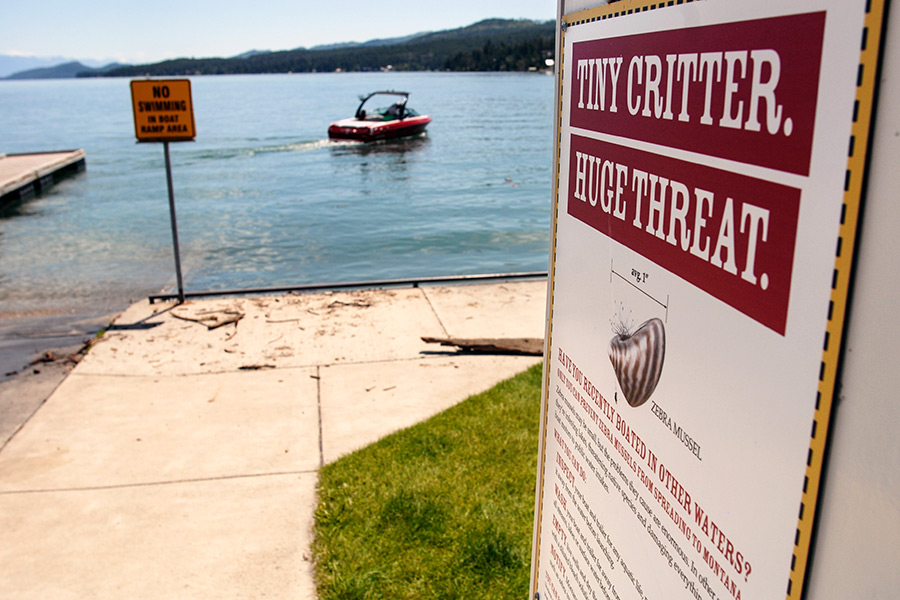Faced with the threat of aquatic invasive mussels spreading across Montana, state agencies have imposed immediate restrictions on Tiber and Canyon Ferry reservoirs where the species have been detected while water samples from across the state have been sent to out-of-state labs to identify the scope of the contamination.
The Montana Mussel Response team announced Thursday evening that temporary emergency orders are restricting the launch and removal of all boats, docks and other structures at both Tiber and Canyon Ferry until the water freezes. Any residents who want to remove structures from the reservoirs must contact state officials for a full inspection, according to Greg Lemon, public information officer with Montana Fish, Wildlife and Parks.
Matt Wolcott, incident commander for the state’s response team, said the restrictions are necessary to prevent the potential spread of invasive aquatic mussels from the two reservoirs to other uncontaminated water bodies in Montana and elsewhere.
State officials are responding to the first detection of aquatic invasive mussels in Montana after larvae were discovered in water samples collected in the summer. Crews are searching for the species in both Tiber and Canyon Ferry to identify if an adult population has already been established.
While the state lab continues to test samples, additional samples from lakes across Montana are being shipped to Colorado and California to be independently tested as soon as possible. Lemon said the agency hopes to receive results in the next two weeks.
Local efforts are underway to study the possible presence of mussels in Northwest Montana waters, including Flathead Lake, which is considered one of the cleanest lakes in the world.
The Flathead Lake Biological Station announced last week it is immediately increasing its monitoring efforts while collecting samples across the Flathead basin to test for any possible signs of aquatic invasive species.
“If these mussels arrive in Flathead Lake, their impact will be catastrophic, damaging water quality, disrupting the food web and our trout fishing, ruining the lakeshore for recreational use, decreasing shoreline property values and increasing the cost of hydroelectricity. Our lake will never be the same,” Bio Station Director Jim Elser said in an alert newsletter published last week.
The restrictions on Tiber and Canyon Ferry took effect a day after Montana Gov. Steve Bullock declared a statewide natural resource emergency for Montana water bodies in light of the detection.
The miniscule mussels, which cling to boats and other watercraft and can colonize rapidly, threaten to have ecological and economic consequences. Once zebra and quagga mussels become established in a water body, they are impossible to fully eradicate.
On Nov. 8, FWP announced that larvae of aquatic invasive mussels had been detected in water samples from Tiber Reservoir. Ongoing sampling and testing found “suspect” samples from Canyon Ferry Reservoir, the Milk River downstream of Nelson Reservoir, and the Missouri River upstream from Townsend.
In the days following the state’s announcement, the National Park Service closed all waters in Glacier National Park to watercraft, along with the Blackfeet Nation, which closed reservation waters to all boats. The U.S. Fish and Wildlife Service closed the Jessup Mill Pond near Creston to all boating access.
According to Lemon, FWP collected 540 water samples from 140 water bodies in late spring and summer. The testing is part of a regular monitoring program. Samples are tested at FWP’s laboratory in Helena.
Lemon said the state was notified on Oct. 17 by the U.S. Bureau of Reclamation that a suspect sample had been discovered in Tiber Reservoir. The state prioritized its water samples from Tiber while also gathering additional samples. An independent lab and the state’s lab both confirmed the positive detection of larvae of an unidentified invasive mussel, either a quagga or zebra, Lemon said. Additional testing identified suspect detections in Canyon Ferry, Lemon said.
On Nov. 18, U.S. Sen. Steve Daines, R-Montana, sent a letter to the U.S. Army Corps of Engineers seeking funding for watercraft inspection stations and other expedited measures.
“The State of Montana has already spent nearly $1 million on operating 16 inspection stations this year,” Daines stated. “Montana has plans to expand the number and hours of inspections stations to further mitigate this threat. However, the federal match is urgently needed by April 1st, 2017, before next year’s water recreation season begins and Montana sees an exponential increase in boat traffic and risk. I urge the Corps to expeditiously complete any necessary guidance documents and release these critical funds to states, so they can conduct this imperative work.”
The restrictions on Tiber and Canyon Ferry were approved Dec. 1 by the directors of the Montana Department of Natural Resources and Conservation and Montana Department of Fish, Wildlife & Parks. Residents who need to remove a boat, dock or other structure during the closure period can contact the Mussel Response Team at (406) 444-2440 to request assistance.
